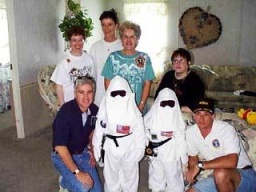NASA
Helps Kids Discover Their Planet
Partnerships between Federal agencies and other organizations are a central part of reinvention. They can get results no single entity can. Some of these partnerships have large ambitions, others affect fewer people, but in no less significant ways. Just ask Mikie Walker....
Like an astronaut setting foot on a new world, Mikie Walker of Virginia Beach, VA, explores the mysteries of Earth during daylight hours. What makes this so unusual for a seven-year-old boy? Mikie has porphryia, a genetic disorder that causes extreme and potentially dangerous sunlight sensitivity. Exposure to sunlight can result in chronic skin inflammation, blistering, inflammation of nerves, abdominal pain, and other disturbances. For Mikie, and other children with serious light- sensitivity disorders, even a 40-watt light bulb can be dangerous. Playing outside is unthinkable -- at least it was until recently. Now, thanks to expanded partnerships among the National Aeronautics and Space Administration (NASA), industry, and non-profit organizations, advanced space technology is being applied to meeting the needs of Earth-bound customers, especially the children.
NASA
Partners for Community Solutions
On
April 19, 1998, Mikie was freed from his lonely, dark world
when he became the first American child to own a modified,
pint-sized "space suit" that protects him from the
sun's ultraviolet rays and other light sources. NASA's Johnson
Space Center (JSC) in Houston, Texas, offered the suit to
Mikie through an agreement with the not-for-profit HED (hypohidrotic
ectodermal dysplasia) and Related Disorders Foundation in
Hampton, VA. The HED Foundation donates cooling gear and other
garments to children with HED, multiple sclerosis, spina bifida,
cerebral palsy, and other genetic disorders.
Mikie
sports an improved version of the pair of prototype protective
suits the JSC team provided in September 1997 to four-year-old
Kyle and two-year-old Ryan Richards of Shotton Colliery, England.
The brothers have Polymorphic Light Reaction Syndrome, another
rare genetic defect that causes a serious allergy to light.
Solutions
Start with Asking for Help
"An
English newspaper journalist approached us…on behalf
of the Richards family," said Robert Dotts, Assistant
Director of Technology Transfer and Commercialization  at
JSC. After discussions with the family, NASA formed a small
team and "set about defining suit requirements, identifying
possible materials, and testing them," continued Dotts.
Based on test results, NASA engineers designed a two-layer
suit and an active cooling system to keep the children comfortable
inside the suits. The finished prototypes consisted of white
jackets, pants, gloves, and headgear, including goggles, that
protected the boys from more than 99.9 percent of the sun’s
ultraviolet rays.
at
JSC. After discussions with the family, NASA formed a small
team and "set about defining suit requirements, identifying
possible materials, and testing them," continued Dotts.
Based on test results, NASA engineers designed a two-layer
suit and an active cooling system to keep the children comfortable
inside the suits. The finished prototypes consisted of white
jackets, pants, gloves, and headgear, including goggles, that
protected the boys from more than 99.9 percent of the sun’s
ultraviolet rays.
The
JSC team - - Robert Dotts and NASA engineers Dominic Del Rosso
and Evelyne Orndorff, and NASA physician, Dr. Smith Johnston
- - delivered the suits to the Richards family in Orlando,
Florida. Without the suits, the brothers could venture outside
only at night. But, looking like junior astronauts, Kyle and
Ryan wore their protective suits all over Disney World, and
they also viewed a Space Shuttle launch at the Kennedy Space
Center in Cape Canaveral, Florida. Ryan went outside during
daylight hours for the first time that day.
Thanks
to the "expert" feedback provided by Kyle and Ryan
Richards, NASA’s JSC team upgraded the protective garment,
and Mikie Walker's mini-space suit has improved ventilation
throughout and less overheating in the head area. "The
body cooling system was changed from a battery-powered liquid
pump unit to a passive phase change vest, made of material
similar to refrigerator cold packs used for sports injuries.
The vest is simpler, less expensive, and more durable than
the original battery pump," said Robert Dotts. The new
vest is easier to use for both children and their families,
and, according to Dotts, the cost of the entire suit is considerably
lower than the prototype.
Like
Kyle and Ryan Richards in England, Mikie is enjoying his days
in the sun. "Mikie's new favorite outdoor activities
include playing in dirt and rolling on the lawn," his
mother Angela Walker said. "He enjoys this so much that,
at the end of the day, he resembles a soil-encrusted Apollo
moonwalker."
Technology Transfer and Commercialization: No One Can Do It Alone
Part of Administrator Dan Goldin's leadership in reinventing NASA is ensuring that scientific research benefits all Americans. Under NASA's technology transfer program, private industry gets quick access to new technologies that they can turn into useful products, such as Mikie's space suit. When NASA spins-off technology innovations from the U.S. civil space program, the Agency's industrial partners can move quickly to manufacture practical applications that benefit everyone.
This time, it was MicroClimate Systems, Inc., of Sanford, MI, that supplied the vest, and the Solar Protective Factory of Carmichael, CA, provided the UV protective outer garments. The DRLI Company, which supplies protective coatings for NASA astronauts' space suit helmets, supplied the clear UV-blocking coating for Mikie's ski-goggle-like face
visor.
For
more information about UV protective suits for children with
applicable disorders, contact the HED Foundation at P.O. Box
9421, Hampton, VA 23670, telephone (757) 826-0065.
For
more information about NASA’s technology spin-offs and
industrial partnerships, visit the NASA Internet site.
10/18/99
Home |
Privacy |
Contents |
Comments |
Email Me |
Search